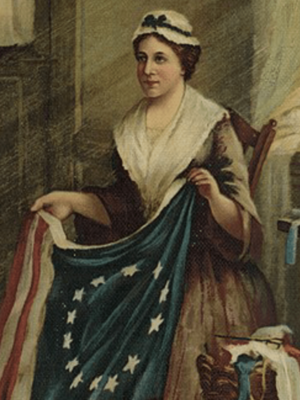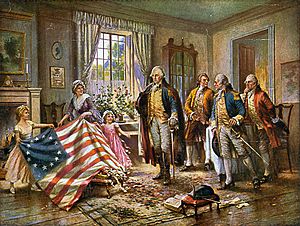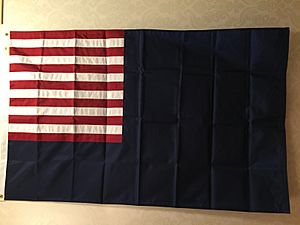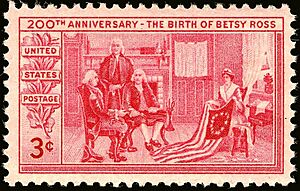Betsy Ross facts for kids
Quick facts for kids
Betsy Ross
|
|
|---|---|

Posthumous depiction of Ross in 1893
|
|
| Born |
Elizabeth Griscom
January 1, 1752 |
| Died | January 30, 1836 (aged 84) Philadelphia, Pennsylvania, U.S.
|
| Occupation | Upholsterer |
| Years active | 1768–1833 |
| Spouse(s) |
John Ross
(m. 1773; Joseph Ashburn
(m. 1777; John Claypoole
(m. 1783; |
| Children | 7 |
| Parents |
|
| Family |
|
| Signature | |
Elizabeth Griscom Ross (born Griscom; January 1, 1752 – January 30, 1836) was an American upholsterer. She is famous for a story told by her family in 1870. They said she made the first official U.S. flag. This flag is now known as the Betsy Ross flag.
Most historians don't believe the story is true. But the Ross family tradition says that General George Washington visited Mrs. Ross in 1776. He was with two members of a special committee: Robert Morris and George Ross. The story claims that Mrs. Ross showed George Washington how to cut a five-pointed star easily. She convinced him to use five-pointed stars instead of six-pointed ones on the flag design he showed her. However, there are no old records or other proof to support this story. It seems the story first appeared in her grandson's writings about 100 years after it supposedly happened.
Even if she didn't make the first U.S. flag, Betsy Ross was a real flag maker. She made flags for the Pennsylvania navy during the American Revolutionary War. After the war, she continued making U.S. flags for over 50 years. This included 50 large flags for the U.S. Arsenal in Philadelphia in 1811. The Pennsylvania Navy Board oversaw the flags for the state's ships. In 1775, Benjamin Franklin was the head of the Committee of Safety, which included Robert Morris and George Ross. This committee ordered flags for their new gunboats.
Betsy Ross was one of the people hired to make these flags. Records from May 29, 1777, show an order to pay her for her work. It says she received "fourteen pounds twelve shillings and two pence for Making Ships Colours." These "ship colors" included different types of flags. One was a blue flag with 13 stripes (seven red and six white) in the top-left corner. This flag was flown from the back of the ship. Other flags were long, narrow pennants, mostly red, flown from the ship's masts.
Contents
Early Life and Learning to Sew
Betsy Ross was born on January 1, 1752. Her parents were Samuel and Rebecca Griscom. She grew up on a farm in Gloucester City, New Jersey. Betsy was one of 17 children, but only nine of them lived to be adults.
Her family were Quakers. This meant they lived a simple life with strict rules. Betsy learned to sew from her great-aunt, Sarah Elizabeth Ann Griscom. Her great-grandfather, Andrew Griscom, was a Quaker carpenter who came from England in 1680.
After finishing school at a Quaker school, Betsy became an apprentice. She worked for an upholsterer named William Webster. An upholsterer makes and repairs furniture, especially by adding padding, springs, and fabric covers. This is where she learned her valuable skills.
The Famous "First Flag" Story

For a long time, many people believed that Betsy Ross designed the "first U.S. flag". This flag, with its circle of stars, became a strong symbol of the American Revolution. It showed the spirit of the new country. You can see it in many famous paintings from after the war, like General George Washington at Trenton.
The popular story says that a group of founding fathers asked Ross to make the flag. The legend claims she changed the design. She supposedly took the six-pointed stars they suggested and made them into five-pointed stars instead. She showed them how much easier it was to cut a five-pointed star.
However, historians don't agree on what the first U.S. flag looked like. They also don't know for sure who made it. Many flag makers and upholsterers worked in Philadelphia during that time. For example, Margaret Manny might have made an earlier flag called the Continental Colors. Other flag makers included Rebecca Young and Anne King. It's possible that many different people made early American flags. So, there might not have been just one "first" flag.
The story about Betsy Ross making the first flag was first told in 1870. Her grandson, William J. Canby, shared it in a paper. He said his aunt told him the story in 1857, many years after Betsy Ross had died. Canby believed the event happened in 1776, a year before the Second Continental Congress officially passed the first Flag Act in 1777.
Today, many experts think that Betsy Ross's only possible contribution was changing the stars from six points to five. They often give credit to Francis Hopkinson, a member of the Continental Congress, for arranging the stars.
Her Life and Family

While working as an upholsterer, Betsy Griscom met John Ross. He was the nephew of George Ross Jr, who signed the United States Declaration of Independence. Betsy and John fell in love and got married in 1773. They had to elope (run away to get married) because her Quaker family did not approve. Her marriage also meant she was no longer part of the Quaker church.
The young couple started their own upholstery business. They joined Christ Church, where they sometimes saw important people like George Washington. Betsy and John Ross did not have any children.
The American Revolutionary War began two years after they married. John Ross joined the local Pennsylvania militia to guard supplies. He died in 1775. Betsy, who was 24, kept working in her upholstery business. She repaired uniforms and made tents and blankets for the Continental Army.
On June 15, 1777, Betsy married her second husband, Joseph Ashburn. He was a sailor. In 1780, a British ship captured Joseph's ship. He was put in prison in England and later died there. During this sad time, their first daughter, Zilla, died young. Their second daughter, Eliza, was born.
Three years later, in May 1783, she married John Claypoole. He had met Joseph Ashburn in the English prison and told Betsy about Joseph's death. John Claypoole's old diary and family Bible were found again in 2020.
Betsy and John Claypoole had five daughters: Clarissa, Susanna, Jane, Rachel, and Harriet (who died as a baby). In 1786, they moved to a bigger house in Philadelphia. Philadelphia became the temporary capital of the new United States.
In 1793, Betsy's mother, father, and sister all died from a serious illness called yellow fever. After many years of poor health, John Claypoole died in 1817. Betsy continued her upholstery business for another 10 years. When she retired, she moved in with her daughter Susanna. Her oldest daughter, Clarissa, took over the business in the city.
Death and Burial Places

Betsy Ross became completely blind in her later years. She spent her last three years living with her daughter Jane in Philadelphia. Betsy Ross died on January 30, 1836, at the age of 84. She lived 60 years after the Declaration of Independence was signed. She was survived by one daughter from her second marriage (Eliza) and four daughters from her third marriage (Clarissa, Susanna, Jane, and Rachel).
The famous Betsy Ross House in Philadelphia is a popular place for tourists. However, historians still debate if she actually lived in that specific house. Some evidence suggests she lived in a house next door that was later torn down.
Betsy Ross was first buried in a Quaker burial ground in Philadelphia. In 1856, her remains and those of her third husband, John Claypoole, were moved to Mount Moriah Cemetery. This was a common practice for cemeteries to attract visitors. The Daughters of the American Revolution put up a flagpole at her grave site to honor her.
In 1975, before the United States Bicentennial (200th anniversary of the U.S.), city leaders decided to move her remains again. They wanted to move them to the courtyard of the Betsy Ross House. But when workers looked under her tombstone, they found no remains. Bones found nearby in the family plot were believed to be hers. These bones were then reburied in the grave that tourists visit today at the Betsy Ross House.
Her Legacy
The Betsy Ross Bridge, which connects Philadelphia with Pennsauken Township, New Jersey, is named after her. It crosses the Delaware River.
Some historians, like Marla Miller, suggest that Betsy Ross's importance isn't just about one flag. Instead, her story helps us understand the lives of working women and men during the American Revolution.
Betsy Ross School in Mahwah, New Jersey is also named in her honor.
Betsy Ross Postage Stamp
On January 1, 1952, the U.S. Post Office released a special postage stamp. It honored the 200th anniversary of Betsy Ross's birth. The stamp shows her giving the new 13-striped, 13-starred flag to George Washington. Robert Morris and George Ross are also shown. The picture on the stamp came from a painting by Charles H. Weisberger. He was one of the people who helped care for the Betsy Ross House. This stamp was issued when the Betsy Ross flag story was still widely believed by many Americans.
Images for kids
See also
 In Spanish: Betsy Ross para niños
In Spanish: Betsy Ross para niños




